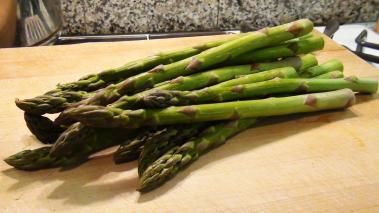How to Cook Asparagus
One of my favorite vegetables is Asparagus. In the Spring time, when it’s fresh, and local, I can’t get enough of it, and I cook it in some way, shape, or form at least twice a week. Not only is the taste great, but it goes well with all kinds of dishes; from the heaviest red meat, to the most delicate fish. And asparagus is also really good for you. But How to Cook Asparagus? There are a ton of different ways, and you can get very creative; but it helps to know the basics. Below, I go through a few key asparagus cooking fundamentals; then following that, asparagus cooking techniques, preparation suggestions, and finally some of my favorite asparagus recipes.
The Keys to Cooking Great Asparagus
- Overcooking: With any cooking technique, one of the things you need to avoid is overcooking the asparagus. As asparagus get over cooked a few things happen – and they are all bad. The spears become mushy. They turn a dull, gross color. And they start to taste more bitter and sulfuric.
- What’s the “right” doneness?: There is room for preference in determine when asparagus is “well cooked”. I lean towards the al dente; while others may like a more tender stalk. With either, you can tell doneness by inserting a knife into a stalk. The easier it goes in and comes out, the more cooked the asparagus is
- Cooking methods: Different cooking methods may impart their own distinct flavors. Some, like steaming, keep the asparagus in its most “natural” state. Others, like grilling will add smoky/charred elements. You can use these different techniques to highlight or mute down the natural flavors and to add new ones.
Asparagus Cooking methods
Steaming Asparagus- Pros: Very simple to do, quick, and little prep work. Unadulterated asparagus taste
- Cons: A bit boring. Unadulterated asparagus taste; no chance to jazz it up
- Technique: Drop the asparagus into about an inch of salted, boiling water for 3 – 4 minutes, until just tender. Drain, season with salt and pepper, a pat of butter and enjoy
- Pros: Can easily add additional ingredients & flavors, Good way to get some caramelization
- Cons: A bit labor intensive
- Technique: Bring a saute pan up to temperature over medium high heat, and add a bit of olive oil or butter. Toss in the asparagus, and saute with a dash of salt and pepper tossing every few minutes. You can other other ingredients, like herbs, bacon, nuts, shallots and garlic as they cook.
- Pros: Let’s you prep ahead of time, sets a nice green color, saves time at dinner time
- Cons: Only the first a two step cooking process
- Technique: Boil the asparagus a quart+ of salted water for 2 – 3 minutes. Remove before they are tender, and cool immediately in an ice bath to stop the cooking process and set the color.
- Pros: Adds a unique charred/smoky flavor; pretty easy
- Cons: The stalks can slip through the grill; they may burn on you if you don’t watch them
- Technique: Get your grill good and hot, and while it heats, toss the asparagus with some olive oil, salt and pepper. Lay perpendicular to your grill grate, and let cook for 2 – 3 minutes. Rotate the stalks, cook the other side for 1 – 2 minutes, until they are tender
- Pros: Easy - put in oven and forget; Generally part of a casserole or other dish
- Cons: Easy to overcook, gotta turn on the oven
- Technique: If you’re cooking them alone, toss with olive oil, salt/pepper in a baking dish, and then put them into a 375 degree oven for about 15 minutes or until tender. Remove and enjoy.
- Whole Asparagus– There is probably no more attractive presentation than serving whole asparagus cooked to perfection. Remove the woody bottom of the stalk by bending it until it breaks at the point the tender top becomes tough. Cook via your favorite method.
- Chopped Asparagus – You may want to chop your asparagus to make it easier to eat, or to match the shape of the other foods (diced chicken, penne pasta, julienned vegetables, etc) on the plate. The chopped asparagus will cook faster so be careful. You can also cut the asparagus on the bias, so each piece has diagonal edges; which looks cool, but doesn’t change the flavor.
- Diced Asparagus– If you finely chop the asparagus, you end up with a dice. Again, I use this technique to match the size of other foods on the plate, or when I’m making a succotash or hash like dish.
- Shaved Asparagus– Great for salads, you can use a vegetable peeler to make thin shavings of cooked asparagus. Hold the stalk flat on the cutting board, and run the peeler over it, to get nicely shaved pieces.
- How to Blanch Asparagus
- How to Clean Asparagus
- Asparagus Bacon & Pine Nuts
- Asparagus Soup
- Gnocchi with Asparagus & Bacon
- Asparagus Risotto with Lemon
- Asparagus Potato Soup
- Grilled Asparagus
- Asparagus Mushroom Pizza
- Asparagus Mushroom Mac 'n Cheese
- Asparagus Sauteed with Shallots
I’m sure that I’ve left out a whole bunch of useful tips, and great recipes. If you have anything to share leave a comment down below and let everyone know.

Comments (3 )